At approximately 9pm on Saturday, Australian time, Meghan Markle will emerge into the glare of countless flashbulbs as she arrives at St George's Chapel, Windsor for her marriage to Prince Harry.
It's the moment the world is waiting for - to see the dress worn by the 36-year-old American actress.
But adding to the glamour - and sparkling in the light of those flashing cameras - is assumed to be a tiara, fixed ever so carefully upon her head. A modern soon-to-be royal, she may eschew a headpiece, making the ultimate statement against tradition. But history suggests a tiara will be there.
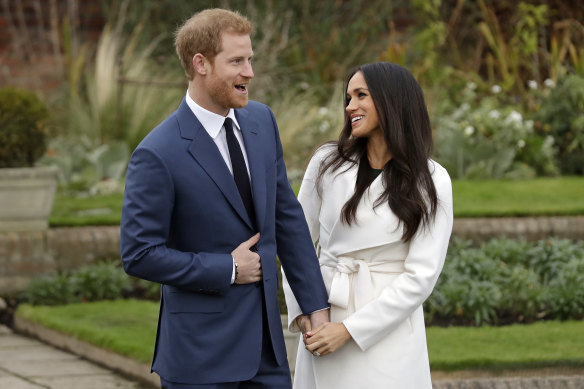
The world is waiting to see what Meghan Markle will be wearing to her wedding to Prince Harry.
National Gallery of Australia director Gerard Vaughan is a man who knows more than most about the importance of a tiara.
Cartier: The Exhibition, now on at the NGA, features 18 tiaras, including from Queen Elizabeth's personal collection and, significantly, the Halo tiara she lent to Kate Middleton for her marriage to Prince William in 2011.
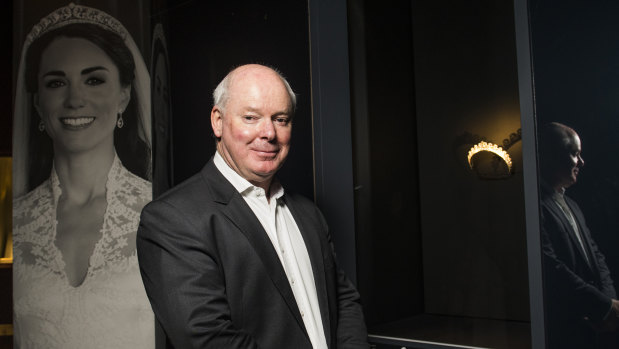
National Gallery of Australia director Gerard Vaughan with the Halo tiara worn by Kate Middleton for her wedding to Prince William in 2011.Credit: Elesa Kurtz
The exhibition has attracted international attention and makes it the place to be in Canberra if you want to indulge in some royal wedding fever. (Why not make it a really royal visit and see the exhibition during the Queen's birthday long weekend, June 9-11?)
The tiaras each have a fascinating story attached to them, worn by queens, princesses, American heiresses, society It girls, and Hollywood royalty turned legit royalty (we're looking at you Grace Kelly, aka Princess of Monaco.)
The incredibly beautiful confections are a link to history; to the mores of another time, to an elite strata of society.
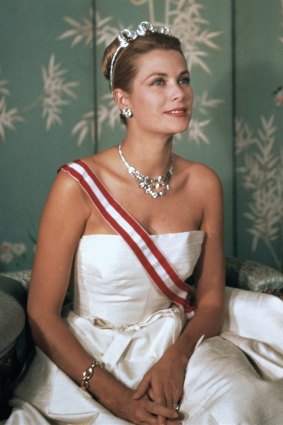
Official portrait of Her Serene Highness Princess Grace of Monaco wearing Cartier jewellery 1959, © G. Lukomski
"We forget that a lady of any substance or who had any pretensions in society, right through the 19th century, up until the Second World War, if they went to a grand dinner, went to the opera, if you were invited to a royal occasion, a woman had to wear a tiara. A woman had to have one. It was part of the kit,'' Mr Vaughan said.
Five pieces of jewellery are from the Queen's personal collection, the gallery starting discussions with the head of the royal collection more than two years ago. Mr Vaughan met with the keeper of the royal collection at St James' Palace in London to negotiate the loan of the stunning jewels. The Halo tiara, for a start, features a room-shining 933 diamonds, first commissioned from Cartier by the then Duke of York for his wife, the Duchess of York, later better known as the Queen Mother, who later gave it to her daughter Elizabeth.
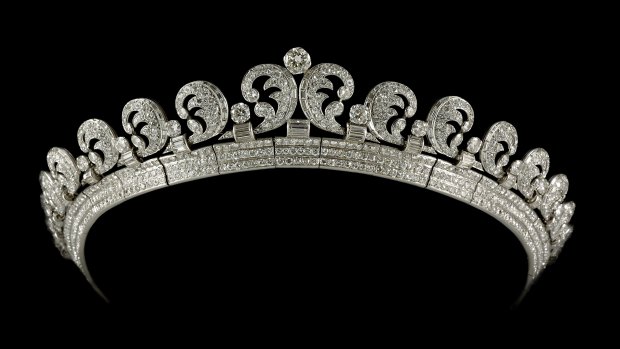
Cartier London Halo tiara 1936, platinum, diamonds, 3 x 18 cm, lent by Her Majesty Queen Elizabeth II, Royal Collection Trust/All Rights Reserve
"The Queen has never loaned a group of her jewels like this before,'' Mr Vaughan said.
"It really makes the show very special, which is why it's getting international attention because this is a remarkable thing.
"I mean, we're part of the Commonwealth, and, of course, this building was opened by the Queen in 1982. So I think that when we went and had our first discussions with the royal collection, there was an awareness that there's a relationship with Australia's National Gallery.
"As they indicated then, they had to work out what the Queen might or might not need to wear during the period of this [exhibition] but they would hope and expect it would be possible for us to borrow from the royal collection, which is really amazing.''
One of the most colourful tiaras in the exhibition is a riot of rubies, emeralds, sapphires and diamonds once owned by one-time American heiress Edwina Mountbatten, wife of Louis Mountbatten, the uncle of Prince Phillip and the supposed inspiration for the name of the new baby, Prince Louis.
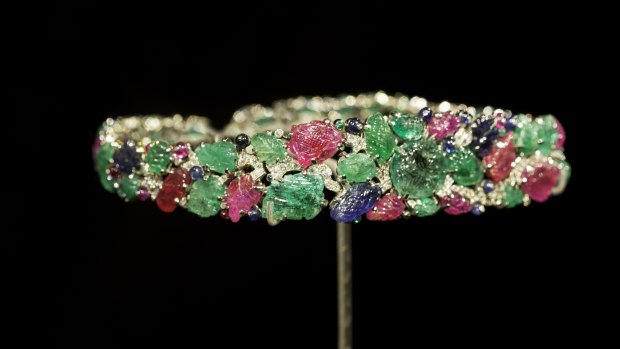
Cartier London Tutti Frutti bandeau 1928, platinum, emeralds, rubies, sapphires, diamonds, lent through the generosity of William and Judith, and Douglas and James Bollinger, on longterm loan to Victoria and Albert Museum, London, Photo: Victoria and Albert Museum, London
The 1928 tiara is of the times, in a bandeau style to suit the shorter hair of the flapper period, but also reflecting the Cartier brothers' push into India. It can also break into two bracelets, reflecting the engineering prowess of the jewellery as much as its inherent beauty.
"One of the features of all Cartier jewels is all the parts move. So when the wearer moves, the jewellery moves with the wearer,'' Mr Vaughan said.
His favourite tiara in the exhibition is one once owned by Princess Marie Louise, a grand-daughter of Queen Victoria, in the 1930s.
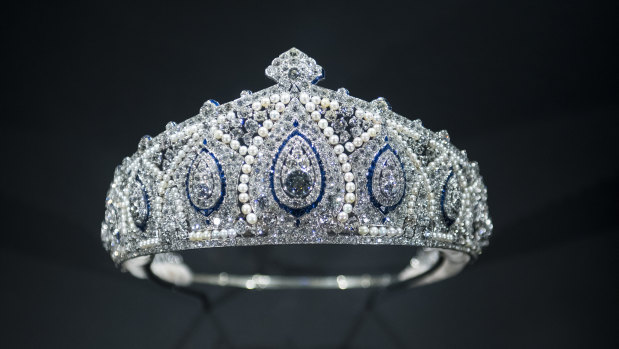
Cartier Paris Gloucester Indian tiara c1906–21, platinum, diamonds, sapphires, pearls, Their Royal Highnesses the Duke and Duchess of Glouceste
"It's very, very glamorous,'' he said. "What I like about it is that it has a very different shape to most and a slightly exotic, Eastern feel. And there's a bit of debate about it: 'Is it because the Cartier brothers in designing this were thinking a little bit about India or maybe Byzantium?'.''
And there is an Australian - in fact, Canberra - connection to the stunning headpiece.
Princess Marie Louise in 1956 upon her death bequeathed the tiara to her royal cousins Duke and Duchess of Gloucester, the Duke being the the 11th Governor-General of Australia, in the 1940s.
"So the family lived here in Canberra,'' Mr Vaughan said.
"And this [tiara] has never been lent before. Ever.''
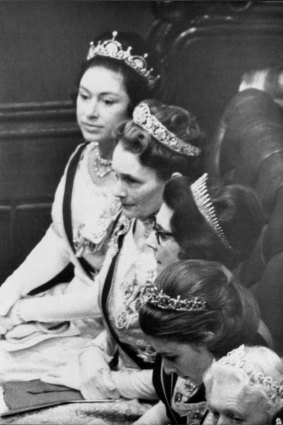
Tiaras en masse at a 1964 opening of Parliament.
The importance of personal connections to securing pieces for the exhibition is never more evident than in this tiara. Mr Vaughan knew the current Duke of Gloucester from his time in London as director of the British Museum Development Trust. Amazingly, they also had a personal connection, in that Vaughan was born in Devonport, Tasmania, the same town the Duke of Gloucester used to take his family for summer holidays during his tenure as Governor-General. So the negotiations for the loan of the tiara became that little bit easier.
"We got in touch and we said, 'We know you don't lend this, but this is for Canberra. You spent part of your childhood in Canberra and it would be fantastic to have that link to the family','' Mr Vaughan said.
"And the Duke and Duchess came straight back and said, 'It would be great, we'd love to lend'. It is very special.''
Also in the exhibition is a tiara worn at the 1902 coronation of Edward VII, the Queen's great-grandfather, a piece reflecting Cartier's desire to "create fashion, not follow it''.
"This is what I call the transitional style. It's very, very different to a classic tiara of the late 19th century,'' he said.
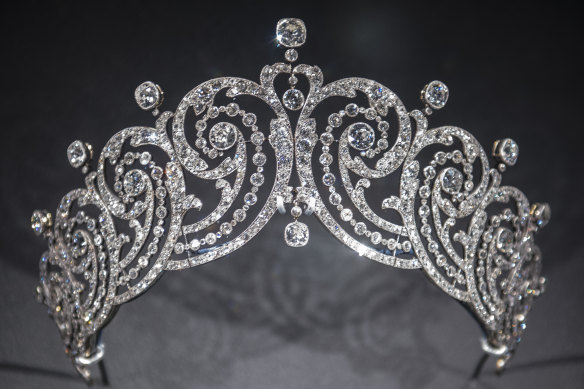
Cartier Paris Scroll tiara 1902, special order, silver, gold, diamonds, 8.1 cm (height at centre), Photo: Nils Herrmann, Cartier Collection, © Cartier
"What is different and special about the Cartier style is that you can hardly see what these jewels are hanging on, which is a very thin band of platinum.
"Until then, everyone would make frames for tiaras out of silver or gold. But to take all that weight, the bands of silver and gold had to be quite thick. Platinum is really, really hard so you can have a thin band of platinum and the frame disappears.
"The whole point of the Cartier style in the 20th century, at least until the Second World War, is to be streamlined. And this is the beginning of this new style they're developing.
"By having a very thin band, light, when it hits it, goes right through the tiara and illuminates every facet of the diamond. So a Cartier tiara will be many times more shiny and sparkling than a more old-fashioned one where a thick band of gold or silver stops the light from shining through.''
The evolution of the Cartier tiara even reflected the advent of one of the great developments in the modern world, the advent of electricity.
"Through the 1890s and into the 1900s, the great interiors of London houses and Parisian salons were being electrified,'' Mr Vaughan said.
"Now, old-fashioned tiaras with these thick gold and silver bands were terrible under electric light. Cartier designed their tiaras for the new electric light to go right through them and illuminate all around.
"In 1910, if you walked into a room, a great gathering of European royalty and aristocracy, and all the women were wearing tiaras, you would instantly know who'd been to Cartier and who hadn't, who'd dusted down their grandmother's tiara from long ago.
"It was absolutely a hallmark of being up-to-date and stylish.''
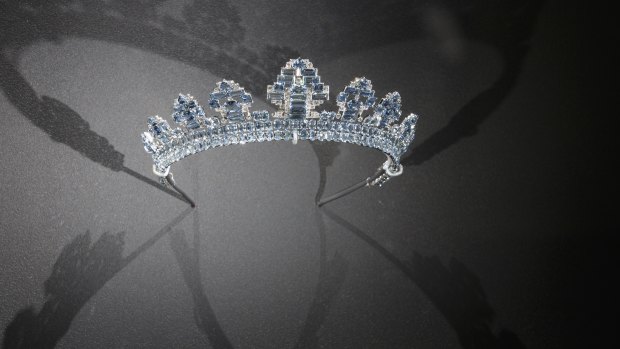
Cartier London Tiara 1937, platinum, diamonds, aquamarines, 5 cm (height at centre), Photo: Vincent Wulveryck, Cartier Collection, © Cartier
Coronations were big business of Cartier. The 1937 coronation of George VI, saw the London jewellery house commissioned to make 27 new tiaras for the event. They asked if the tiaras could be exhibited at their Bond Street headquarters.
"And the whole of London came,'' Mr Vaughan said.
Prince Albert of Monaco also agreed to have some of his mother's jewels be part of the exhibition, including a tiara once worn by Princess Grace of Monaco, which can also, ingeniously can be broken up and worn as three brooches.
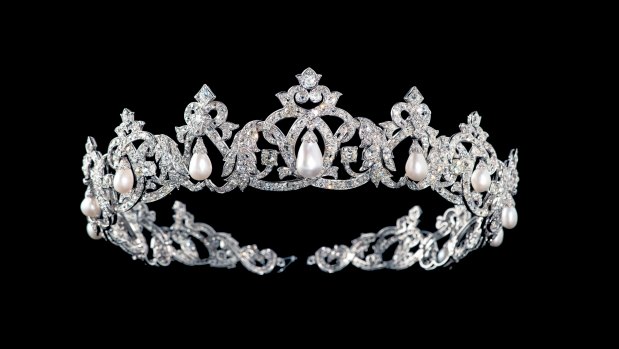
Cartier Paris Tiara 1949, special order, platinum, white gold, diamonds, pearls, 18 x 4.5 cm, Photo: Agence Realis, © Princely Palace of Monaco
"People have been incredibly generous,'' Mr Vaughan said.
"We were really surprised, to be frank. We asked for far more things than we ever believed we would ever be allowed to borrow.''
The tiaras were worn by fascinating people.
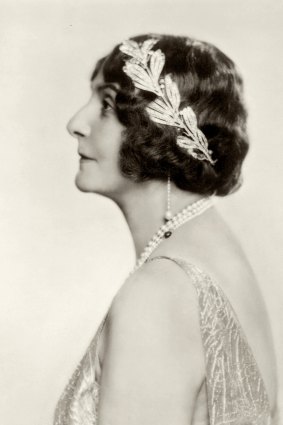
Princess Marie Bonaparte wearing her laurel leaf tiara, 1930
Another stunning tiara was once owned by Princess Marie Bonaparte, a great-great niece of the Emperor Napoleon.
"She was a very interesting person. An author and psychoanalyst who was a friend of Freud,'' Mr Vaughan said.
The sheer brilliance, and assumed price tags, of the jewels is almost overwhelming. The royal family of Qatar have loaned a tiara - and, almost as an aside, one of the largest sapphire in the world, weighing in at 478 carats and once owned by Queen Marie of Romania, another grand-daughter of Queen Victoria.
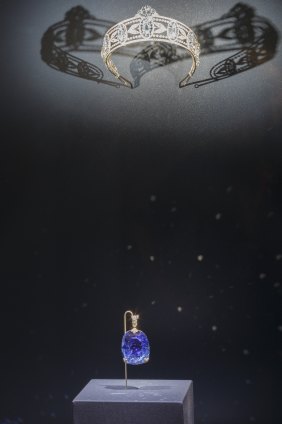
Items loaned by the royal family of Qatar including a tiara and one of the world's largest sapphires.
The value of the tiaras, like all the items in the 300-piece exhibition, remains top-secret.
Even the original prices are never revealed, part of the Cartier promise of life-time privacy. Needless to say, Mr Vaughan says "this is the strictest security we've ever had for any exhibition''. And while no one can touch the jewels, you can take a selfie with them as they sparkle behind the glass and at least pretend to be a princess for a day.
- Cartier: The Exhibition is open at the National Gallery of Australia until July 22.